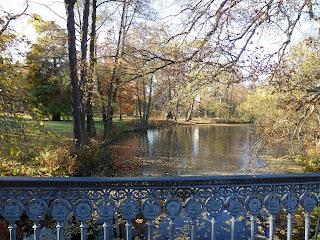Okay, the Cold War is over, the Berlin Wall has been
commodified into tacky souvenir fragments of doubtful authenticity, and
Checkpoint Charlie is now a great place for a photograph with your girlfriend.
In the current vogue for “Ostalgie” precipitated by the 2003 film Goodbye Lenin!, I take a trip across
East and West Berlin, starting wherelse but Alexanderplatz. Once a bleak void
of Soviet urban planning, it is now cluttered with equally tasteless new
commercial developments. Yet the Weltzeituhr and similarly futuristic
Fernsehturm still stand as reminders of the 1960s DDR, as do a seated Marx and
Engels by the Spree, installed exactly the same year as Margaret Thatcher’s Big
Bang. Lenin, however, has long said goodbye.
My visa expires at midnight, so I head back to Charlottenberg
from Friedrichstrasse U-Bahn, past the lines of Red Army guards. I start the next day with West Berlin’s cultural showcase, the Kulturforum near Potsdamer Platz.
Past the Staatsbibliothek and Philharmonie, both built in the 1960s, to the Gemäldegalerie, a vast fine
art collection brought back together in 1998 after Berlin’s reunification.
Highlights include Caravaggio’s Amor
Vincit Omnia, several Dürers
and one of the best Rembrandt collections I have encountered anywhere. Moses with the Tablets of the Law,
pictured, was especially admired by Sigmund Freud, who hung a reproduction in
his Hampstead house.
Enough culture – now for some Currywurst! This dish was
probably invented by occupying British soldiers in the immediate aftermath of
the Second World War. It combines sausages, a German (and British) staple with
a sauce made of ketchup, Worcestershire sauce and curry powder. Order yours “ohne
darm”, without skin, with chips or a bread roll. Curry 36 is one of the oldest
in Berlin, located in Kreuzberg by Mehringdamm U-Bahn.
Next, a nice jolly down the Unter den Linden, possibly
Berlin’s most elegant thoroughfare, towards the Brandenburg Gate and Norman
Foster’s Reichstag, Donald Trump protest permitting.
A day of non-stop walking requires some relaxation, and
where better than the Stadtbad
Neukölln? Built in
1914, this Roman-style public bathhouse has giant order columns to spare,
reminding you of what civic architecture used to mean. Somewhat off the tourist
circuit, its generous spa facilities are good value and well worth a visit.
The Neukölln
district, the inspiration behind a track on David Bowie’s Heroes album of 1977, has a large Turkish immigrant population.
Kreuzberg is said to be the birthplace of the Döner kebab, and any excuse for one is a good excuse!
After a visit to the Schloss Charlottenberg, much of which
is under construction, and a lunch of Berliner Eisbein (boiled ham hock with pease
pudding, mashed potato and Sauerkraut), I dress for the opera, namely Meyerbeer’s
Les Huguenots at the Deutsche Oper
with star tenor Juan Diego Florez as Raoul. A five-hour extravaganza loosely
based on the St Bartholomew’s Day Massacre, it is often discussed – usually
disparagingly – but rarely heard. Compared perhaps to Rossini’s William Tell or Verdi’s Don Carlo it is somewhat banal, yet as
spectacular theatre it remains a benchmark. Numerous airs from it stand the
test of time, not least “Plus blanche que la blanche Hermine”, “Piff Paff” and “Nobles
seigneurs, salut!”.
Before I head back to the airport there is still time to
visit the Museuminsel, or what remains that isn’t under construction. The Pergamum
Museum with its dazzlingly coloured Ishtar Gate, transported brick by brick
from the site of Nebuchadnezzar II’s palace in Babylon, is a must. I then climb
the Berliner Dom for the best views of the city.
To quote Boris Johnson on a recent official visit, “Ich bin
nicht ein Berliner” (which should have been kein)
– to which I add, “bis bald”!









Why are they protesting Trump in Berlin? Do they think he can hear them from there??
ReplyDeleteGreat blog! Looks like such a great time - can't wait to go for myself.
The American Embassy is right next to the Brandenburg Gate. I agree - it's completely pointless!
ReplyDelete